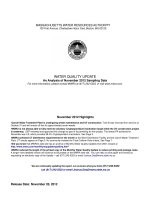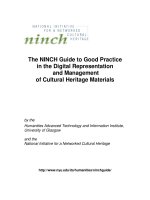Long-term trends in water quality in an under-populated watershed and influence of precipitation
Bạn đang xem bản rút gọn của tài liệu. Xem và tải ngay bản đầy đủ của tài liệu tại đây (335.59 KB, 14 trang )
Journal of Water and Environment Technology, Vol. 7, No. 4, 2009
- 293 -
Long-term trends in water quality in an
under-populated watershed and influence of
precipitation
Ikuo TAKEDA*, Akira FUKUSHIMA**, Hiroaki SOMURA*
*Faculty of Life and Environmental Science, Shimane University, 1060 Nishikawatsu, Matsue,
690-8504, Japan
** Emeritus Professor, Shimane University, 1060 Nishikawatsu, Matsue, 690-8504, Japan
ABSTRACT
An investigation of the water quality in an under-populated watershed was conducted over a
15-year period in which data was collected at weekly intervals. The purposes of this study were
to analyze the long-term trends in water quality and to evaluate the relationship between the
water quality and precipitation. Concentrations of total phosphorus (T–P), chemical oxygen
demand (COD), and suspended solids (SS) reached remarkably high values under heavy
precipitation conditions, and these concentrations increased exponentially with the amount of
precipitation. Over the course of this study, the population, number of factories, animals (cow
and pig), and area of agricultural land exhibited clearly decreasing trends, while steady progress
in domestic wastewater treatment was realized. However, no clear decrease in the parameters of
water quality was observed, and some nitrogen, phosphorus, and COD concentrations increased
even though no significant change in precipitation occurred. A possible hypothesis explaining
this lack of a clear decrease in water quality is that specific pollutant outflows from forests and
agricultural lands may have increased in recent years. This is because poorly managed forests
and agricultural lands in the under-populated watershed have adversely affected the water quality
of the rivers.
Keywords: long-term trend, precipitation, under-populated watershed, water quality.
INTRODUCTION
In recent years, the deterioration of water quality in closed water areas such as lakes,
reservoirs, and ponds has been regarded as one of the most serious problems threatening
the aquatic environment. In Japan, the water quality in many such areas has not shown
clear improvement in the last 30 years and the chemical oxygen demand (COD) in the
water meets environmental standards in only 40–50% of cases (Ministry of
Environment of Japan, 2008). Two of those lakes that fail to meet COD standards are
Lake Shinji (area = 79.2 km
2
, mean depth = 4.5 m) and Lake Nakaumi (86.8 km
2
, 5.4
m) in the eastern part of Shimane Prefecture, which are representative of brackish lakes
in Japan. In these lakes, the water quality has never met the expected environmental
standards for total nitrogen (T–N), total phosphorus (T–P), and COD, which are 0.4 mg
L
-1
, 0.03 mg L
-1
, and 3 mg L
-1
, respectively (Shimane Prefecture, 2008a). In addition,
blooms of blue-green algae and red tide are occasionally observed. On the other hand,
the pollutant fluxes from terrestrial areas, which can have a marked effect on the aquatic
environment in lakes, can differ greatly from year to year, because the water quality and
pollutant load in rivers is strongly influenced by the uncontrollable hydrological
condition of precipitation. Therefore, it is necessary to investigate long-term trends
regarding water quality and pollutant load in rivers.
Address correspondence to Ikuo Takeda, Faculty of Life and Environmental Science, Shimane University
Email:
Received: July 17, 2009, Accepted: October 24, 2009
Journal of Water and Environment Technology, Vol. 7, No. 4, 2009
- 294 -
The migration of a large number of people from rural to urban areas is a trend observed
not only in Japan but throughout the world. In rural areas, this migration can cause
depopulation, aging of the local population, and a consequent increase in poorly
managed forests and agricultural lands. Therefore, increased migration may adversely
affect the water quality in the aquatic environment. However, sufficient data on water
quality and pollutant loads in under-populated watersheds have not been collected, nor
has an effective evaluation been conducted.
We have been investigating the water quality in an under-populated watershed since
August 1991 by measuring the levels of nitrogen, phosphorus, organic matter, and
suspended solids (SS) at weekly intervals. For this investigation, the watershed of the
Hii River was chosen as the study site since it is the largest river flowing into Lake
Shinji and the population in the watershed had been decreasing. The purposes of this
study were to analyze the long-term trends in the water quality of an under-populated
watershed for the period from 1992 to 2006 and to evaluate the relationship between the
water quality and precipitation.
This study focuses on the amount of precipitation as a hydrological factor affecting the
aquatic environment, because strong relationships have been reported between the
amounts of precipitation and the pollutant loads in several watersheds (Kunimatsu and
Sudo, 1997; Sugimoto et al., 2008). Moreover, a greater amount of reliable data is
available on precipitation than on runoff. For example, in the governmental monitoring
system in Japan, the amount of precipitation is monitored at about 1300 stations using
the Automated Meteorological Data Acquisition System (AMeDAS), and these data are
made available to the public almost immediately (e.g., Japan Meteorological Agency,
2006). On the other hand, the amount of runoff is monitored at only about 370 stations
and the data are made available a few years after collection (e.g., Japan River
Association, 2008). Therefore, determining the relationship between water quality and
precipitation would be useful for evaluating the aquatic environment even if the runoff
data could not be obtained.
MATERIALS AND METHODS
Study site
In this study, the Hii River located in the eastern part of Shimane Prefecture was chosen
as the study site (Fig. 1). Water in the Hii River was sampled every week at points H1
(midstream) and H2 (downstream). The areas of the watershed at points H1 and H2 are
451 and 911 km
2
, respectively, and their land-use characteristics are similar with a large
amount of forested land. Specifically, the land use at the H1 watershed was 83.5% forest,
8.7% agricultural, 0.8% residential, and 7.0% for other purposes while the land use at
the H2 watershed was 80.8% forest, 10.0% agricultural, 1.4% residential, and 7.8% for
other purposes. Table 1 shows the changes in several point sources and various
domestic wastewater treatments performed from 1990 to 2005, which were estimated
from statistical data and information obtained from Shimane Prefectural Government
(e.g., Shimane Prefecture, 2000; Shimane Prefecture,2006; Shimane Prefecture, 2008b).
Since accurate statistical data are not available for the number of hens, these data are not
listed in this table. The population of H1 and H2 watersheds decreased by 10.3% and
Journal of Water and Environment Technology, Vol. 7, No. 4, 2009
- 295 -
7.8%, respectively, between 1990 and 2005. In this period, the number of factories and
animals also decreased. In 2000, the population densities of H1 and H2 watersheds were
calculated to be 46 and 78 inhabitants km
-2
, respectively, whereas the average
population density in Japan was 342 inhabitants km
-2
. Accordingly, the studied
Table 1 - Changes in several point sources and domestic wastewater treatments
in watersheds.
Fig. 1 - Location of Hii River watershed and sampling points.
Watershed Item 1990 1995 2000 2005
H1 Population 22,300 21,700 20,900 20,100
Domestic wastewater treatment
Sewerage (%) 6.2 9.2 13.7 16.6
Small sewerage in rural area (%) 0.3 3.6 7.0 9.6
Domestic septic tank (%) 9.3 13.4 18.4 31.4
Factory 206 173 149 123
Animals
Cow 7,600 8,150 6,540 6,800
Pig 0 0 0 0
H2 Population 75,500 73,900 71,700 69,700
Domestic wastewater treatment
Sewerage (%) 8.6 12.7 18.7 22.4
Small sewerage in rural area (%) 0.3 3.8 7.1 9.4
Domestic septic tank (%) 10.0 14.3 19.4 32.7
Factory 319 277 240 196
Animals
Cow 11,800 11,800 9,680 9,730
Pig 290 80 40 30
Journal of Water and Environment Technology, Vol. 7, No. 4, 2009
- 296 -
watershed is characterized as an under-populated watershed with a pronounced
depopulation trend. On the other hand, domestic wastewater treatment clearly increased.
For example, the percentage of domestic wastewater treatment (sewerage, small
sewerage in rural areas, and domestic septic tanks) in the H2 watershed increased from
18.9% in 1990 to 64.5% in 2005. Therefore, pollutant emissions originating from
domestic wastewater were expected to decrease during this period.
Water quality analysis
The methods for analyzing the water quality of the collected samples were in
accordance with Japanese Industrial Standard (JIS) K 0102 (Namiki, 1993): T–N was
measured by UV absorption spectroscopy after alkaline potassium peroxodisulfate
decomposition; ammonium nitrogen (NH
4
–N) was measured by the indophenol blue
method; nitrate nitrogen (NO
3
–N) was measured by ion chromatography using a
Shimadzu HIC–6A system; T–P was measured by the ascorbic acid reduction
molybdenum blue method after potassium peroxodisulfate decomposition; phosphate
phosphorus (PO
4
–P) was measured by the ascorbic acid reduction molybdenum blue
method; COD was measured by the potassium permanganate method; and SS was
measured by the glass fiber filter paper method (pore size = 0.45 μm; Advanted GS25).
Among the measured parameters of water quality, NO
3
–N and COD have been analyzed
since March 1993 and the qualitative analyses for NO
3
–N, NH
4
–N, and PO
4
–P were
conducted after filtration.
Collection of precipitation data
The daily precipitation data was obtained from the AMeDAS as stated above. The
arithmetic averages of the data from four monitoring points located in or near the Hii
River watershed were used as the precipitation data (Fig. 1). The altitude of these points
varied from 20 to 369 m.
RESULTS
Changes in concentration
Figure 2 shows the changes in the concentrations of nitrogen, phosphorus, COD, and
SS at point H2. In addition, the average values and standard deviations of the
concentrations during the entire study period are listed in Table 2. Overall, the levels of
the T–N, T–P, COD, and SS concentrations increased under heavy precipitation
Table 2 – Average (
±
standard deviation) concentrations during the entire
study period.
Parameter H1 H2
T-N (mg L
-1
) 0.577
±
0.338 0.636
±
0.329
NH
4
-N (mg L
-1
) 0.038
±
0.028 0.032
±
0.028
NO
3
-N (mg L
-1
) 0.349
±
0.135 0.378
±
0.154
T-P ( mg L
-1
) 0.035
±
0.053 0.043
±
0.055
PO
4
-P (mg L
-1
) 0.011
±
0.006 0.013
±
0.006
COD (mg L
-1
) 1.6
±
2.1 1.7
±
1.4
SS (mg L
-1
) 7.7
±
23.1 9.6
±
22.6
Journal of Water and Environment Technology, Vol. 7, No. 4, 2009
- 297 -
conditions. However, all heavy precipitations do not have the concentration peaks,
because the concentrations are weekly data while the precipitations are the daily
averages. Among these peaks, many of the T–P, COD, and SS concentrations are
considerably higher than the corresponding averages (T–P = 0.043 mg L
-1
, COD = 1.7
mg L
-1
, SS = 9.6 mg L
-1
), and many peaks of T–N concentration are relatively higher
than the corresponding average (0.636 mg L
-1
). On the other hand, the concentrations of
inorganic substances (NH
4
-N, NO
3
–N, PO
4
–P) fluctuated within a very narrow range.
Cross-correlation analysis revealed high correlations between SS and T–N (R
2
= 0.816;
p < 0.01 at point H1, R
2
= 0.720; p < 0.01 at point H2), SS and T–P (R
2
= 0.859; p <
Fig. 2 - Changes in concentrations of different parameters at point H2 (weekly
sampling) and precipitation (daily average at 4 monitoring points).









